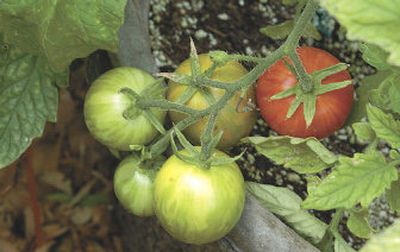Help for green tomatoes

Well folks, our vegetable gardens are in the home stretch. In a few short weeks we will be facing freezing temperatures and the end of the garden. Unfortunately, it wasn’t all that long ago that we were facing cold wet weather trying hard just to get the gardens started. This year has given new meaning to the term “short growing season.”
We finally got some nice hot weather the latter part of July, but many plants had been so slowed down by the earlier cool wet weather that they weren’t ready to flower and take advantage of the heat. So they were playing catch-up when they should have had ripe fruit. We need to help them out.
Tomatoes and peppers need night temperatures between 55 and 60 degrees to set fruit, and warm 80-ish dry days to ripen it. We got the nighttime temperatures in that range from the middle of July through about the middle of August, and plants that were blooming did set fruit. We may still get some very warm days but they may happen only in short stretches.
Trapping heat around our plants takes a little ingenuity but is relatively simple. For the most part you are trying to trap only a few degrees to accomplish your goal, because five degrees at night can make all the difference.
If wind is a problem in your garden, put up a wind break of plastic or burlap near but not on the plants. The barrier should be between 3- and 4-feet high and staked securely so it won’t blow down. The wind will hit the barrier and then roll up and over it and your plants. With the wind off the plants, the temperature will rise behind the screen by a few degrees. Set a thermometer out before and after to see the difference.
Next, trap the heat close to individual plants. One of the best ways to do this is by using polyester growing fabric (often called Remay). When this lightweight porous fabric is placed over plants or wrapped around them, it can raise the temperature by two to seven degrees at night and 10 degrees during the day; more than enough to set and ripen fruit. The fabric is available at most garden centers either in pre-cut packages or cut-to-order lengths. With careful handling, it will last two or three seasons.
The material can be placed right over the top of the plants because it is lightweight and lets in air and water. If your tomatoes are staked up in cages, simply wrap it around them and staple it into a sleeve. Leave it loose enough to pull off to pick ripe fruit. If it is laid over plants, anchor it securely to the ground with rocks or stakes so it won’t blow off.
Not only will the fabric hold heat to ripen vegetables, it can buy you protection from our early frosts. Often, we will get a light frost or two, and then get another three or four weeks of decent growing weather. Under those circumstances, the fabric may keep the plants from freezing.
Put large, dark-colored objects amongst the plants to catch the sun’s warmth. Tires, pieces of railroad tie or beams, large rocks and milk jugs filled with water, act like heat sinks soaking up the heat during the day, and release it slowly at night. This method works especially well with smaller plants like peppers.
In my cool microclimate garden, peppers that are close to some railroad ties always produce more than those a couple of feet away. For larger plants, like tomatoes and sprawly squash and cucumbers, scatter the heat sinks around the plants especially near flower clusters.
You can increase your chances of getting fruit to ripen by trimming and clipping leaves a little. Tomato plants can be cut back to stop the plant from putting energy into growing leaves and transfer it to ripening fruit. By doing so, you are scaring the plant into thinking some one is trying to kill it and it needs to ripen seeds to survive.
Clip back leaves around clumps of fruit so the sun can reach them. For squash and melons, trim the growing tips of the vines and then remove the smaller and younger fruits from the plant. The plants will then focus their growing on the fruits you leave. In the case of peppers, trim the growing tip out and remove some leaves to let in the sun.